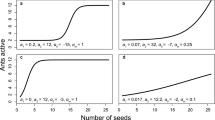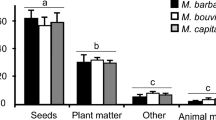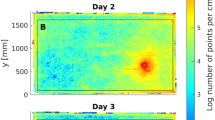Abstract
Foragers of the antsMessor pergandei andPogonomyrmex rugosus experience differing levels of variability in the distribution of seeds they harvest due to species-specific differences in foraging behavior.Messor pergandei foragers experience more variable seed distributions and densities, learn to recognize a novel seed faster but forget this information faster thanP. rugosus, which experiences more constant seed distributions even in the same habitat. Rate of learning to recognize a novel seed species was negatively associated with measures of seed species diversity for both ants.Messor pergandei foragers respond to variation in seed density by varying number of seeds handled per seed harvested, whileP. rugosus foragers do not. Memory of a novel seed exceeds forager longevity, due perhaps to use of seed caches as a type of information center.
Similar content being viewed by others
References
Bowman, G. B. and L. D. Harris, 1980. Effect of spatial heterogeneity on ground-nest predation.J. Wildl. Manage. 44:806–813.
Brandes, C., B. Frisch and R. Menzel, 1988. Time-course of memory formation differs in honey bee lines selected for good and poor learning.Anim. Behav. 36:981–985.
Coombs, C. H., R. M. Dawes and A. Tversky, 1970. Mathematical Psychology. Prentice-Hall, Englewood Cliffs.
Dudai, Y., 1977. Properties of learning and memory inDrosophila melanogaster.J. Comp. Physiol. 114:69–89.
Gordon, D. M., 1986. The dynamics of the daily round of the harvester ant colony (Pogonomyrmex barbatus).Anim. Behav. 34:1402–1419.
Gould, J. L. and P. Marler, 1984. Ethology and natural history of learning. In: Biology of Learning (P. Marler and H. S. Terrace, Eds.). Springer-Verlag, New York, pp 47–74.
Greenberg, R., 1984. Differences in neophobia in the tropical migrant wood warblersDendroica pensylvanica andDendroica castanea.J. Comp. Psychol. 98:131–136.
Hollander, M. and D. A. Wolfe, 1973. Nonparametric Statistical Methods. Wiley, New York.
Hölldobler, B., 1976. Recruitment behavior, home range orientation, and territoriality in harvester ants,Pogonomyrmex.Behav. Ecol. Sociobiol. 1:3–44.
Johnson, R. A., 1991. Learning, memory, and foraging efficiency in two species of desert seed-harvester ants.Ecology 72:1408–1419.
Johnston, T. D., 1982. Selective costs and benefits in the evolution of learning.Adv. Study Behav. 12:65–106.
Johnston, T. D. and M. T. Turvey, 1980. A sketch of an ecological metatheory for theories of learning.Psychol. Learn. Motiv. 14:147–205.
Kintsch, W., 1977. Memory and Cognition. Wiley, New York.
Laverty, T. M. and R. C. Plowright, 1988. Flower handling by bumblebees: a comparison of specialists and generalists.Anim. Behav. 36:733–740.
Lewis, A. C., 1986. Memory constraints and flower choice inPieris rapae.Science 232:863–865.
Martin, T. E., 1988. On the advantage of being different: nest predation and the coexistence of bird species.Proc. Natl. Acad. Sci. (USA)85:2196–2199.
McGregor, P. K. and M. I. Avery, 1986. The unsung song of great tits (Parus major): learning neighbors' songs for discrimination.Behav. Ecol. Sociobiol. 18:311–316.
NOAA (National Oceanic and Atmospheric Administration), 1985.Climatological Data for Arizona, 89, Nos. 1–3 (National Climatic Data Center, Asheville, NC).
NOAA, 1986.Climatological Data for Arizona, 90, Nos. 1–3 (National Climatic Data Center, Asheville, NC).
NOAA, 1987.Climatological Data for Arizona, 91, Nos. 1–3 (National Climatic Data Center, Asheville, NC).
Pietriwicz, A. T. and A. C. Kamil, 1979. Search image formation in the blue jayCyanocitta cristata.Science 204:1332–1333.
Porter, S. D. and C. O. Jorgensen, 1981. Foragers of the harvester ant,Pogonomyrmex owyheei: a disposable caste?Behav. Ecol. Sociobiol. 9:247–256.
Reichman, O. J., 1984. Spatial and temporal variation of seed distributions in Sonoran Desert soils.J. Biogeog. 11:1–11.
Rissing, S. W., 1988. Dietary similarity and foraging range of two seed-harvester ants during resource fluctuations.Oecologia (Berlin)75:362–366.
Rissing, S. W. and J. Wheeler, 1976. Foraging response ofVeromessor pergandei to changes in seed production (Hymenoptera: Formicidae).Pan-Pac. Entomol. 52:63–72.
Sasvàri, L., 1979. Observational learning in great, blue, and marsh tits.Anim. Behav. 27:767–771.
Shettleworth, S., 1984. Learning and behavioural ecology. In: Behavioural ecology: an evolutionary approach (J. R. Krebs and N. B. Davies, Eds.). Sinauer, Sunderland, pp. 170–194.
Sokal, R. R. and F. J. Rohlf, 1981. Biometry. Freeman, San Francisco.
Wheeler, J. and S. W. Rissing, 1975. Natural history ofVeromessor pergandei. II. Behavior (Hymenoptera: Formicidae).Pan-Pac. Entomol. 51:303–314.
Wilson, E. O., 1985. The sociogenesis of insect colonies.Science 228:1489–1495.
Author information
Authors and Affiliations
Rights and permissions
About this article
Cite this article
Johnson, R.A., Rissing, S.W. & Killeen, P.R. Differential learning and memory by co-occurring ant species. Ins. Soc 41, 165–177 (1994). https://doi.org/10.1007/BF01240476
Received:
Revised:
Accepted:
Issue Date:
DOI: https://doi.org/10.1007/BF01240476




